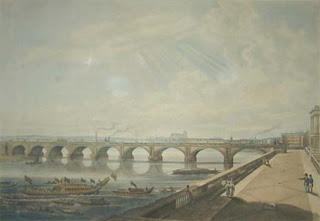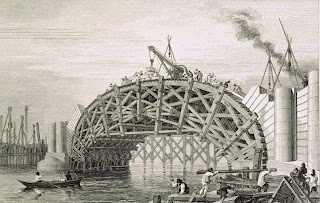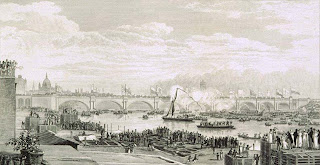 At the time of its completion in 1816, and for many years afterwards, Waterloo Bridge was unquestionably the noblest bridge in Europe, and one can appreciate the opinion of that great artist Canova, who in his enthusiasm exclaimed that to see this bridge alone was worth a journey from Rome to London.
At the time of its completion in 1816, and for many years afterwards, Waterloo Bridge was unquestionably the noblest bridge in Europe, and one can appreciate the opinion of that great artist Canova, who in his enthusiasm exclaimed that to see this bridge alone was worth a journey from Rome to London.The year 1809 was especially distinguished for the prevalence of one of those gambling fevers that seem to have periodically seized the inhabitants of these isles for many centuries, and the idea of a bridge from the Strand, near Somerset House, to the Surrey side of the Thames at Lambeth appears to have originated in the brain of an investor who had been infected with this fever. A company was formed with a capital of £100,000 and sanction was sought from Parliament to build a temporary wooden bridge : the idea of the promoters being that a permanent stone bridge could be built later out of the large profits to be obtained from the tolls on persons and vehicles passing over.
Owing to the opposition of the representatives of the City Of London, who opposed the plan for three successive sessions in Parliament; the company was finally compelled to abandon the project of a wooden bridge and undertake the construction of a stone one. It is interesting to note here that in order to do this the promoters were compelled to increase their capital by an additional £400,000, but so sanguine were they of the ample remuneration to be derived from the toll that this large sum was immediately raised among themselves, and the shares were at a guinea premium the next day.
Owing to the opposition of the representatives of the City Of London, who opposed the plan for three successive sessions in Parliament; the company was finally compelled to abandon the project of a wooden bridge and undertake the construction of a stone one. It is interesting to note here that in order to do this the promoters were compelled to increase their capital by an additional £400,000, but so sanguine were they of the ample remuneration to be derived from the toll that this large sum was immediately raised among themselves, and the shares were at a guinea premium the next day.
The first plan for the bridge was prepared by Mr. George Dodds, a well-known engineer of the day, but the managing committee were apparently not satisfied with his design, and referred it to Mr. John Rennie and Mr. jessop for their opinion. These gentlemen reported that for the most part it was a copy of M. Peyronnet’s celebrated bridge at Neuilly, with modifications rendered necessary by the difference of situation, and the greater width of the river to be spanned. They also pointed out several objections to Mr. Dodd’s design, as well as to the plan he proposed for founding the piers, and as a result of their reprt Mr. Dodds’s plan was abandoned.
When eventually an Act was passed in 1809 authorising the “Strand Bridge Company ” to build a stone bridge from ” some part of the precinct of the Savoy, to the opposite shoreat Cupar’s Bridge in Lambeth,” the committee again applied to Mr. Rennie, and this time they requested him to furnish them with the design of a suitable structure. John Rennie was the son of a farmer of Phantassie, in Haddingtonshire (Scotland), and appears to have obtained his taste for mechanics from Andrew Meikle, a tenant on his father’s estate. This Andrew Meikle, according to the authority of Smiles, was the inventor of the threshing-machine and numerous other inventions. John Rennie became successively a country schoolmaster and master millwright. He then joined Messrs. Watt and Boulton as a confidential assistant. Rennie was now rapidly rising to the front rank in his profession, and his services were continually in demand, and numerous bridges, canals, and docks scattered over the country still give evidence of his industry and ability, for, like Wren and other great engineers, he built for posterity.
 Rennie prepared two designs for the Strand Bridge, one of seven equal river to be spanned. They also arches and the other of nine; the pointed out several objections to Mr. latter being eventually chosen by the Dodds’s design, as well as to the committee as the less costly.
Rennie prepared two designs for the Strand Bridge, one of seven equal river to be spanned. They also arches and the other of nine; the pointed out several objections to Mr. latter being eventually chosen by the Dodds’s design, as well as to the committee as the less costly. The first stone of the bridge was laid on October 11, 1811. One interesting story concerning the construction of the bridge is well worth recording, and it is given here practically as it occurs in Smiles’ “Lives of the Engineers.” Most of the stone required during the construction of the bridge was hewn m some fields adjacent to the erection on the Surrey side. It was transported on to the work upon trucks drawn along railways, in the first instance over temporary bridges of wood; and it is a remarkable circumstance that nearly the whole of the material was drawn by one horse, known as ” Old Jack,” a most sensible animal and a great favourite. His driver was, generally speaking, a steady and trustworthy man, though he had a weakness for a dram before breakfast. As the railway along which the trucks were drawn passed in front of a public-house door, the horse and truck were usually pulled up while Tom entered for his morning dram. On one occasion the driver stayed so long that await the next anniversary of the ” Old Jack,” becoming impatient, oked his head into the open door, and taking his master’s coat-collar between his teeth (Smiles tells us this that year we find the following account was done in a “gentle sort of manner”), pulled him out from the midst of his companions and thus forced him to resume the day’s work.
As the work neared completion, its name was changed from Strand to Waterloo Bridge for reasons which are thus expressed in the Act of Parliament of 1816, which relates to the matter: “Whereas the said bridge, when completed, will be a work of great stability and magnificence, and such works are adapted to transmit to posterity the remembrance of great and glorious achievements, and whereas the company of proprietors are desirous that a designation should be given to the said bridge, which shall be a lasting record of the brilliant and decisive victory (Waterloo), achieved by his Majesty’s forces, in conjunction with those of his allies, on the 18th day of June, 1815.”
 The bridge was completed soon after this, but the same patriotic reason that had influenced Parliament in changing its name caused them to await the next anniversary of the victory at Waterloo, and so the bridge was not opened until June 18, 1817. In the “Gentleman’s Magazine” of that year we find the following account of the opening ceremoniy: “June 18, 1817 – This day . . the magnificent new bridge which crosses the Thames from the Strand was opened with appropriate ceremonies. In the forenoon a dtetachment of the Horse Guards posted themselves on the bridge, and about three o’clock a discharge of two hundred and two guns, in commemoration of the number of cannon taken from the enemy, an nounced the arrival of the Prince Regent, and other illustrious person ages, who came in barges from the Earl of Liverpool’s at Whitehall. The royal party passed through the central arch, and landed on the Surrey side, a where the procession formed. It was lasting rheaded by the Prince Regent; with the Duke of York on his right and the Duke of Wellington on his left, in the uniform of field-marshals; followed by a train of noblemen, gentlemen, ministers and members of both Houses of Parliament. On reaching the Middlesex side of the bridge, the company re-embarked and retured to Whitehall. Every spot commanding a view of the bridge was crowded with spectators.”
The bridge was completed soon after this, but the same patriotic reason that had influenced Parliament in changing its name caused them to await the next anniversary of the victory at Waterloo, and so the bridge was not opened until June 18, 1817. In the “Gentleman’s Magazine” of that year we find the following account of the opening ceremoniy: “June 18, 1817 – This day . . the magnificent new bridge which crosses the Thames from the Strand was opened with appropriate ceremonies. In the forenoon a dtetachment of the Horse Guards posted themselves on the bridge, and about three o’clock a discharge of two hundred and two guns, in commemoration of the number of cannon taken from the enemy, an nounced the arrival of the Prince Regent, and other illustrious person ages, who came in barges from the Earl of Liverpool’s at Whitehall. The royal party passed through the central arch, and landed on the Surrey side, a where the procession formed. It was lasting rheaded by the Prince Regent; with the Duke of York on his right and the Duke of Wellington on his left, in the uniform of field-marshals; followed by a train of noblemen, gentlemen, ministers and members of both Houses of Parliament. On reaching the Middlesex side of the bridge, the company re-embarked and retured to Whitehall. Every spot commanding a view of the bridge was crowded with spectators.”
How funny! I had to do a bit of research on this bridge for my third manuscript (set in April,1817) as I have my hero walking through London in the rain, retracing his late mistress's funeral route. He takes a short cut by crossing the not yet open Waterloo Bridge. For some reason when I was mapping out the route a bell went off about this particular bridge, so I did a bit of research and I was glad I did. Now I know to come here for little tidbits like that!
Louisa – We hope you'll visit often! We also hope to make this blog a nice mix of serious research material, timely posts and assorted bits of nonsense. Thanks so much for becoming a follower – we're thrilled! Kristine